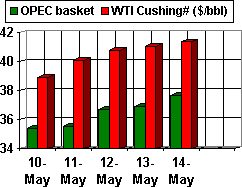Now that the milestone has been reached, oil markets should worry less about $40/bbl oil and more about $50/bbl oil.
Even Saudi Arabia's pledges and certain follow-through to supply more crude to the market has done little to chill a white-hot oil market. The fact remains that there isn't that much room to boost supply without obliterating what little spare capacity cushion there is. Considering that a major contributor to the state of current high oil prices is a lack of inventory cushion, erosion of the production capacity cushion at the same time is a prescription for even higher prices.
And it may just take $50/bbl or more to undermine one of the main drivers of high oil prices: unexpected strength in oil demand growth. In the meantime, the other main driver of high prices, geopolitical supply threats, is not likely to fade for some timeThink: Iran-Iraq tanker war of the 1980s and then some.
Demand-led spike
The oil market today is a mirror image of those in 1998that is, a reverse reflection rather than an exact duplication.
In 1998, the Organization of Petroleum Exporting Countries pumped a lot more oil into markets just as Asian demand slumped. This year (as was the case last year), OPEC is putting less oil into markets just as demandparticularly China'sspikes to record levels.
"It seemed like a good idea at the time" doesn't play any better today for OPEC than it did in 1999, even with the market inverted.
The Saudi call for quotas to be raised won't do much to help curb demand growth. In theory, it might prevent some crude buyers from making purchases now in anticipation of lower prices tomorrow. But in reality, with the inventory cushion so thin today, there isn't that kind of flexibility.
And the wild card in this game is Chinese oil demand, registering a staggering growth rate of 10%/year. Speculation grows that Beijing will cool that blistering growth pace itself this summer with a series of steps designed to keep inflation under control, which in turn will curb oil demand growth.
But it would have to take a pretty huge drop in Chinese demand to allow refiners to build stocks back up to a comfortable level again. With global economic recovery still in full swing, doil emand isn't likely to drop significantly in the near term. The Centre for Global Energy Studies notes that gross domestic product in the Organization of Economic Cooperation and Development nations is expected to rise by 3.5% this year; US GDP is projected to rise by 4.7%. In addition, oil consumers in Europe and parts of Asia until recently have been shielded from the full impact of higher oil prices because of the weaker US dollar and their high taxes on oil products, says the London think tank.
Solutions
OPEC is all but certain to hike production quotas at the group's ministerial meeting in Junelikely along the lines of the Saudis' recommendation for a 1.5 million b/d increase. But such an increase in quotas would seem to be, at first blush, moot in terms of actual supply because OPEC already is exceeding its quota by 2 million b/d.
However, if nothing else, the quota increase gives the Saudisand perhaps a few other OPEC membersofficial cover for boosting their own production still further, so that OPEC ends up producing as much as 3.5-4 million b/d over last year's quota.
There already have been reports of Saudi Arabia booking more tankers to boost supplies to the US beginning in July. A little more stocks cushion will help calm a market more jumpy than a two-tailed cat in a roomful of rocking chairs.
But the kingdom, and others in OPEC, will keep a watchful eye on crude inventories in the interim. If stock cover starts to rise appreciably in the late summer and early fall, that could spur OPEC to throttle back on overproduction to prevent a repeat of 1998.
And there isn't likely to be much relief on the products end, thanks to a continuing tightbecause of infrastructure constraintsUS gasoline supply and likely inability to build distillate stocks in the fall.
With Nigeria and Venezuela aboil, oil and products stocks low, and terrorists targeting Saudi and Iraqi oil facilities, the market's on a razor's edge. Any future surprise will be how we managed to get through 2004 without oil hitting $50/bbl at least once.
(Author's e-mail: [email protected])
OGJ HOTLINE MARKET PULSE
Latest Prices as of May 17, 2004
null
null
null
null
null
null
NOTE: Because of holidays, lack of data availability, or rescheduling of chart publication, prices shown may not always reflect the immediate preceding 5 days.
Futures price, next month delivery. #Spot price.







